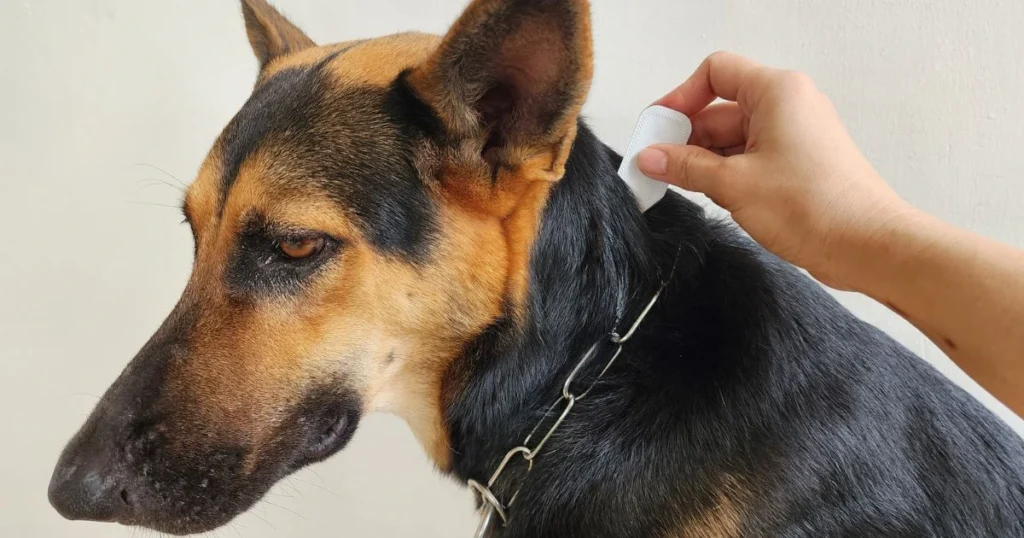Flea spray for dogs is essential for any pet owner aiming to keep their furry friends comfortable and healthy. With effective flea and tick spray, pet owners can provide a protective barrier against these common pests. Many dog owners find themselves facing the problem of fleas and ticks, especially during warmer months when these parasites thrive.
Choosing the right dog flea spray can make all the difference in ensuring a pest-free environment. Various products are available, each formulated to target fleas and ticks at different life stages, offering a range of options for effective control. Understanding the ingredients and application methods can help pet owners select the best option for their dog’s needs.
By exploring the different types of flea sprays and their benefits, pet owners can make informed decisions to protect their dogs. Finding a suitable flea and tick spray for dogs is not just about repelling pests; it’s about enhancing a beloved pet’s overall health and well-being.
Understanding Fleas and Their Risks to Dogs
Fleas are more than just a nuisance; they pose various health risks to dogs. Knowing their lifecycle and potential health implications is essential for any dog owner.
Lifecycle of Fleas
Adult fleas thrive in warm, humid environments and often jump onto hosts like dogs. The lifecycle consists of four stages: egg, larva, pupa, and adult.
- Egg: Flea eggs are laid on the host but fall off into the environment. They can hatch in as little as 1-10 days.
- Larva: Larvae feed on organic debris, including adult flea feces, in dark, sheltered areas. This stage lasts about 5-11 days.
- Pupa: Depending on environmental conditions, the pupal stage can last several weeks to months. Fleas can remain dormant until they sense a host nearby.
- Adult: Once they emerge, adult fleas live for several weeks to months, feeding on blood. A female flea can lay up to 50 eggs per day.
Understanding this lifecycle helps in effective flea control and prevention.
Health Risks Posed by Fleas
Fleas can lead to various health issues in dogs. These may include:
- Skin Irritations: Flea saliva causes allergic reactions, leading to itching, redness, and hair loss.
- Anemia: Heavy infestations can lead to significant blood loss, particularly in puppies or small dogs.
- Tapeworms: Fleas can carry tapeworms, which dogs may ingest while grooming themselves.
Monitoring a dog for signs of flea activity is crucial. Symptoms include constant scratching, biting at the skin, and visible fleas or flea dirt. Immediate action is necessary to prevent further complications. Regular flea prevention is vital for maintaining a dog’s health.
Types of Flea Sprays for Dogs

Flea sprays for dogs come in various formulations to combat infestations effectively. Knowing the differences helps in selecting the appropriate product for specific needs. Here are the main categories:
Chemical-Based Sprays
Chemical-based sprays are designed to kill fleas quickly using specific insecticides. Common active ingredients include pyrethroids and neonicotinoids, which disrupt fleas’ nervous systems. These sprays often provide immediate relief and are suitable for severe infestations.
When using chemical-based options, following the manufacturer’s instructions closely to ensure safety is essential. They can be effective on both adult fleas and their larvae. However, some pets may experience adverse reactions, so monitoring for any signs of irritation is crucial.
Natural Flea Sprays
Natural flea sprays incorporate ingredients derived from plants and essential oils. Options like neem, lavender, and witch hazel are popular choices. These all-natural dog flea sprays are less likely to cause skin irritation and may appeal to pet owners seeking eco-friendly solutions.
While their effectiveness can vary, many pet owners find these sprays beneficial for light flea problems. They typically need to be reapplied more frequently than chemical sprays. Before larger applications, it’s advisable to perform a patch test to ensure no allergic reactions occur.
Homemade Solutions
Homemade flea and tick spray for dogs allows pet owners to create customized solutions tailored to their pets’ needs. Common ingredients include apple cider vinegar, water, and essential oils like cedarwood or lemongrass. Recipes can vary, but these mixtures can help deter fleas without harsh chemicals.
These solutions are appealing to those looking for a budget-friendly option or wishing to avoid commercial products. However, their efficacy may not match that of professional-grade sprays. Regular application is important; pet owners should observe their pets for any allergic reactions when testing new ingredients.
Selecting the Best Flea Spray

Choosing an effective flea spray for dogs involves understanding key ingredients, considering the animal’s age and health, and assessing both effectiveness and safety. This ensures owners pick the best option tailored to their pet’s needs.
Ingredients to Look for
Ingredients play a crucial role when selecting flea spray. Effective sprays often contain pyrethrins, derived from chrysanthemum flowers, which paralyze and kill fleas quickly. Neonicotinoids like imidacloprid also effectively target flea nervous systems.
Many sprays include natural insecticides like cedarwood or lemongrass oil for owners seeking less harsh alternatives. These natural options provide moderate effectiveness but are safer for sensitive animals. Always check for additional ingredients which may enhance effectiveness or provide soothing properties for skin irritations.
Choosing Based on Dog’s Age and Health
When selecting flea spray, consider a dog’s age and health. Puppies under three months may require different formulations, as their skin can be more sensitive. Sprays specifically labeled safe for puppies should be prioritized.
For older dogs or those with health issues, it’s essential to consult a veterinarian. Certain ingredients can pose risks due to pre-existing conditions or medications. Therefore, products designed for specific health needs can be beneficial. Be sure to read labels and choose products that clearly state suitability for the dog’s age and health conditions.
Effectiveness and Safety
The effectiveness of flea sprays often lies in their formulation. Veterinary-recommended products usually indicate higher reliability in eliminating fleas. Look for sprays with proven efficacy against fleas and ticks, as these can offer broader protection.
Safety is equally important. Some sprays may irritate a dog’s skin or cause allergic reactions. Conduct a patch test by applying a small amount on the dog’s skin before full use. In addition, ensure the product is free from harsh chemicals such as DEET or alcohol, which can be harmful. Opt for brands that provide clear safety guidelines and have been clinically tested.
Application of Flea Sprays

Effective flea spray application is crucial for maintaining a dog’s health and comfort. Proper techniques, frequency of use, and safety measures should be considered to maximize effectiveness and ensure safety.
Proper Application Techniques
For the best results, it is essential to follow the manufacturer’s instructions when using a flea spray on dogs. Owners should first groom their dog to remove any tangles or mats, which can prevent the spray from reaching the skin.
The spray should be applied evenly across the dog’s body, focusing on areas where fleas are likely to hide, such as the tail’s neck, back, and base. It is advisable to hold the spray nozzle about 6-8 inches away from the dog’s coat to ensure even distribution without saturating the fur.
Using a gentle massaging motion can help the product reach the skin, where it is most effective. To prevent irritation, avoid spraying near the dog’s eyes, nose, or mouth.
Frequency of Use
The frequency of applying flea spray on dogs depends on the product’s formulation and the severity of the flea problem. Some flea sprays are designed for daily use, while others may recommend a weekly, bi-weekly, or monthly application.
After application, dog owners should monitor their pets closely for signs of fleas or ticks. If a flea infestation persists, more frequent applications may be necessary, but it’s important to adhere to the guidelines provided on the product label to avoid potential overdosing.
It is vital to treat the pet and the environment regularly. Vacuuming, washing bedding, and using home treatments can enhance the effectiveness of flea sprays and contribute to long-term flea control.
Safety Measures
Safety is a top priority when using spray fleas and ticks for dogs. Pet owners should choose products specifically formulated for dogs, as some flea treatments for other animals can be toxic.
Before applying any flea spray, it is essential to conduct a patch test on a small area of the dog’s skin to check for reactions. If any irritation occurs, discontinue use immediately.
Additionally, keeping the dog away from children and other pets during and shortly after application can help minimize exposure to the chemicals. Always store flea sprays in a secure, cool place, away from sunlight and out of reach of pets and children.
Homemade Flea Control Solutions

Homemade solutions for flea control can be an effective alternative to commercial products. Using natural ingredients, pet owners can create sprays that help manage flea and tick infestations safely.
Ingredients and Recipes
Many ingredients can form the basis of effective homemade flea sprays for dogs. Here are a few popular options:
- Apple Cider Vinegar: This acidic solution can disrupt fleas’ pH levels. Mix equal parts of water and apple cider vinegar in a spray bottle.
- Essential Oils: Using lavender, peppermint, or eucalyptus can repel fleas. Mix 10-15 drops of essential oil with two cups of water and a teaspoon of dish soap.
- Lemon Spray: A lemon solution can also be effective. Slice a lemon and simmer it in water overnight. Strain the liquid and use it as a spray.
The best homemade flea spray for dogs often combines these ingredients. Ensure any solution is safe for the dog and free from harmful chemicals.
Application Tips for Homemade Sprays
Applying homemade flea and tick spray for dogs requires some careful steps. First, thoroughly shake the spray before use to ensure proper mixing of ingredients.
Spray the solution directly onto the dog’s coat, avoiding the eyes, nose, and mouth. Pet owners should focus on areas where fleas are likely to hide, such as beneath the collar, around the ears, and at the base of the tail.
Additionally, it’s advisable to test a small skin area for sensitivity before applying generously. To maintain effectiveness, reapply the spray every few days or after baths.
By using homemade flea spray for dogs with essential oils, pet owners can create a natural barrier against pests while caring for their pets’ health.
Preventative Measures Against Fleas

Preventing fleas is essential for maintaining a dog’s health and comfort. Taking proactive steps can significantly reduce the risk of flea infestations and keep pets safe.
Maintaining a Clean Environment
A clean living space is vital for flea prevention. Regularly vacuuming floors, carpets, and furniture removes flea eggs and larvae. Vacuum bags should be disposed of promptly to prevent reinfestation.
Washing your dog’s bedding, toys, and blankets in hot water every few weeks helps eliminate fleas and their eggs. Additionally, consider using anti-flea sprays in living areas to deter pests from settling.
Keeping the yard tidy is equally essential. Mowing the lawn, trimming shrubs, and removing debris provide fewer hiding spots for fleas, which not only helps with flea management but also makes the outdoor environment more enjoyable.
Regular Grooming and Care
Regular grooming is crucial in spotting and preventing fleas. Brushing the dog’s coat helps remove any existing fleas, dirt, or debris. A flea-repellent spray for dogs during grooming can also provide additional protection.
Bathing your dog with a specialized flea shampoo offers another layer of defense. Frequent bathing may help reduce flea populations and keep the coat healthy.
Veterinary check-ups are equally crucial for preventative care. Discussing flea prevention methods with a veterinarian can lead to tailored treatment options. They may recommend various topical treatments or oral medications to effectively keep fleas at bay.
Evaluating Flea Spray Efficacy

Determining the effectiveness of flea sprays involves recognizing positive outcomes and identifying when additional help is necessary. The following aspects help in making this evaluation.
Signs of Success
A successful flea spray will exhibit clear signs of efficacy. Within a few days of application, dog owners should observe reduced scratching or biting behaviors. This indicates that the spray is effectively targeting fleas.
Additional indicators include:
- Decrease in flea presence: Owners may notice fewer fleas on their pets or living spaces.
- Improved coat condition: Healthy fur and skin can signal relief from flea irritation.
Watch for similar results for natural options, such as essential oil flea spray for dogs. Users often report positive effects when they opt for products combining essential oil flea and tick spray for dogs for added protection. Regularly checking pets and the environment helps to confirm ongoing efficacy while combating flea infestations.
When to Seek Veterinary Assistance
If there is no noticeable improvement within a week, it may be time to consult a veterinarian. Persistent scratching, redness, or inflammation can indicate a more severe issue, such as an allergic reaction to fleas or secondary infections.
In cases of significant flea infestations, especially with pets that experience discomfort, immediate professional advice is recommended.
Additionally, if using an over-the-counter flea treatment, read the instructions carefully. Some dogs might react adversely to specific chemicals. Seeking guidance from a veterinarian ensures the chosen flea spray, including options like essential oil flea spray for dogs, aligns with the dog’s health needs.
Critter Stop offers assistance for broader pest control issues. Their reputation for high-quality work and customer service makes them a reliable choice for any wildlife or pest removal needs. Call Critter Stop at (214) 234-2616 for a free inspection to address potential flea problems effectively.
Frequently Asked Questions
Flea spray for dogs is a standard solution for pet owners seeking to control infestations. The following questions address concerns about effectiveness, safety, and application.
What is the most effective flea spray for dogs?
The effectiveness of flea sprays varies by product. Popular brands often contain ingredients like pyrethroids or natural oils for efficacy.
How does flea and tick spray for dogs work?
Flea and tick sprays typically use active ingredients that target and kill pests upon contact. Some formulations may also repel fleas and ticks to prevent future infestations.
Can I use dog flea spray daily?
Daily use of flea spray is not usually recommended unless specified by the product instructions. Overuse can lead to skin irritation or other health issues.
What is the best flea and tick spray for dogs available?
Top-rated flea and tick sprays often include ingredients based on safety and effectiveness. Reviews and veterinarian recommendations can guide pet owners in choosing the right product.
Are there any natural flea sprays for dogs?
Natural flea sprays can be made with essential oils, vinegar, or other natural ingredients. These options may provide a gentler alternative for sensitive pets.
How can I create a flea and tick spray for dogs at home?
Homemade flea and tick sprays can be crafted using simple ingredients like water, vinegar, and essential oils. Mixing these in a spray bottle can create an effective solution.
What flea sprays are best for dogs?
The best flea sprays often suit the dog’s specific needs regarding age, weight, and health condition. Key features include safety and effective pest control.
What are the benefits of tick and flea spray for dogs?
Tick and flea sprays offer immediate relief from pests, preventing dog discomfort. Regular use can also reduce the risk of infestations and related health issues.
Which is the best homemade flea spray for dogs?
A popular homemade flea spray recipe combines water, vinegar, and essential oils like lavender. This blend is often effective while being relatively safe for dogs.
Can I use flea spray on my dog regularly?
Regular application of flea spray can be necessary, especially during peak flea seasons. Owners should consult product guidelines to determine the appropriate frequency.
Are all-natural flea sprays for dogs effective?
While all-natural flea sprays can be effective, their success may depend on the severity of the infestation. Some may require more frequent application than chemical options.
How does an anti-flea spray for dogs compare to other options?
Anti-flea sprays may provide immediate relief, whereas other treatments like spot-ons or collars offer longer-lasting protection. Each method has its advantages based on the dog’s lifestyle.
How should I apply flea spray to my dog?
Flea spray should be applied evenly across the dog’s body, avoiding the face and genitals. Care should be taken to follow the manufacturer’s application instructions.
What ingredients are effective in homemade tick and flea sprays for dogs?
Effective ingredients in homemade sprays often include vinegar, essential oils such as peppermint, and water. These components can deter pests without harsh chemicals.
Can essential oils be used in flea sprays for dogs?
Essential oils can be included in flea sprays, but some can be toxic to dogs. Owners should research safe options and consult a veterinarian before use.
Is there a specific flea spray for dogs that works best?
There is no single “best” flea spray, as effectiveness can vary among dogs. Veterinary recommendations and product reviews can help identify suitable options.
Are essential oil flea and tick sprays for dogs safe?
Essential oil sprays can be safe, but some oils may cause adverse reactions. To ensure safety, it is advisable to consult with a veterinarian.
What is the best flea and tick spray for dogs on the market?
The best flea and tick spray depends on pet needs and preferences. Popular brands often receive positive reviews for their effectiveness and safety profile.
How effective is a flea repellent spray for dogs?
Flea-repellent sprays can vary in effectiveness, often providing short-term relief from pests. Consistent application may be required for optimal protection.
Can I use homemade flea sprays for dogs with essential oils?
Homemade flea sprays with essential oils can be effective, but safety precautions are essential. Owners should verify which oils are safe for dogs before combining ingredients.
What makes a good flea spray for dogs?
A good flea spray for dogs contains effective ingredients, is safe for the pet, and is easy to apply. Customer reviews and veterinarian endorsements can also indicate quality.
Which flea spray is considered the best for dogs?
The best flea spray can depend on individual pet needs, effectiveness, and ingredient safety. Researching and comparing options can help make an informed decision.
How should I apply flea spray on dogs?
Flea spray should be evenly applied, ensuring coverage while avoiding sensitive areas like eyes and nose. Following product instructions is crucial for safe and effective use.
What are the top spray flea and tick options for dogs?
The top flea and tick sprays are recognized for their effectiveness and safety. Popular options may vary based on specific needs, such as age or health considerations.

